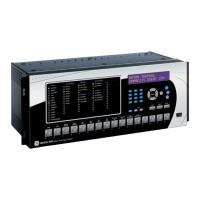5-88 M60 Motor Protection System GE Multilin
5.2 PRODUCT SETUP 5 SETTINGS
5
Direct inputs and outputs are intended for exchange of status information (inputs and outputs) between UR-series relays
connected directly via type 7 digital communications cards. The mechanism is very similar to IEC 61850 GSSE, except that
communications takes place over a non-switchable isolated network and is optimized for speed. On type 7 cards that sup-
port two channels, direct output messages are sent from both channels simultaneously. This effectively sends direct output
messages both ways around a ring configuration. On type 7 cards that support one channel, direct output messages are
sent only in one direction. Messages will be resent (forwarded) when it is determined that the message did not originate at
the receiver.
Direct output message timing is similar to GSSE message timing. Integrity messages (with no state changes) are sent at
least every 1000 ms. Messages with state changes are sent within the main pass scanning the inputs and asserting the
outputs unless the communication channel bandwidth has been exceeded. Two self-tests are performed and signaled by
the following FlexLogic operands:
1.
DIRECT RING BREAK (direct input/output ring break). This FlexLogic operand indicates that direct output messages
sent from a UR-series relay are not being received back by the relay.
2. DIRECT DEVICE 1 OFF to DIRECT DEVICE 16 OFF (direct device offline). These FlexLogic operands indicate that direct
output messages from at least one direct device are not being received.
Direct input and output settings are similar to remote input and output settings. The equivalent of the remote device name
strings for direct inputs and outputs is the
DIRECT OUTPUT DEVICE ID. The DIRECT OUTPUT DEVICE ID setting identifies the
relay in all direct output messages. All UR-series IEDs in a ring should have unique numbers assigned. The IED ID is used
to identify the sender of the direct input and output message.
If the direct input and output scheme is configured to operate in a ring (DIRECT I/O CH1 RING CONFIGURATION or DIRECT I/O
CH2 RING CONFIGURATION is “Yes”), all direct output messages should be received back. If not, the direct input/output ring
break self-test is triggered. The self-test error is signaled by the
DIRECT RING BREAK FlexLogic operand.
Select the
DIRECT I/O DATA RATE to match the data capabilities of the communications channel. All IEDs communicating
over direct inputs and outputs must be set to the same data rate. UR-series IEDs equipped with dual-channel communica-
tions cards apply the same data rate to both channels. Delivery time for direct input and output messages is approximately
0.2 of a power system cycle at 128 kbps and 0.4 of a power system cycle at 64 kbps, per each ‘bridge’.
Table 5–11: DIRECT INPUT AND OUTPUT DATA RATES
MODULE CHANNEL SUPPORTED DATA RATES
74 Channel 1 64 kbps
Channel 2 64 kbps
7L Channel 1 64 kbps, 128 kbps
Channel 2 64 kbps, 128 kbps
7M Channel 1 64 kbps, 128 kbps
Channel 2 64 kbps, 128 kbps
7P Channel 1 64 kbps, 128 kbps
Channel 2 64 kbps, 128 kbps
7T Channel 1 64 kbps, 128 kbps
7W Channel 1 64 kbps, 128 kbps
Channel 2 64 kbps, 128 kbps
7V Channel 1 64 kbps, 128 kbps
Channel 2 64 kbps, 128 kbps
2A Channel 1 64 kbps
2B Channel 1 64 kbps
Channel 2 64 kbps
2G Channel 1 128 kbps
2H Channel 1 128 kbps
2I Channel 1 64 kbps, 128 kbps
Channel 2 64 kbps, 128 kbps
2J Channel 1 64 kbps, 128 kbps
Channel 2 64 kbps, 128 kbps

